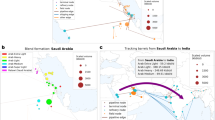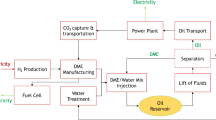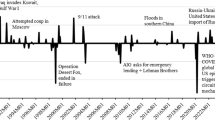Abstract
Expanded use of novel oil extraction technologies has increased the variability of petroleum resources and diversified the carbon footprint of the global oil supply1. Past life-cycle assessment (LCA) studies overlooked upstream emission heterogeneity by assuming that a decline in oil demand will displace average crude oil2. We explore the life-cycle greenhouse gas emissions impacts of marginal crude sources, identifying the upstream carbon intensity (CI) of the producers most sensitive to an oil demand decline (for example, due to a shift to alternative vehicles). We link econometric models of production profitability of 1,933 oilfields (~90% of the 2015 world supply) with their production CI. Then, we examine their response to a decline in demand under three oil market structures. According to our estimates, small demand shocks have different upstream CI implications than large shocks. Irrespective of the market structure, small shocks (−2.5% demand) displace mostly heavy crudes with ~25–54% higher CI than that of the global average. However, this imbalance diminishes as the shocks become bigger and if producers with market power coordinate their response to a demand decline. The carbon emissions benefits of reduction in oil demand are systematically dependent on the magnitude of demand drop and the global oil market structure.
This is a preview of subscription content, access via your institution
Access options
Access Nature and 54 other Nature Portfolio journals
Get Nature+, our best-value online-access subscription
$32.99 / 30 days
cancel any time
Subscribe to this journal
Receive 51 print issues and online access
$199.00 per year
only $3.90 per issue
Buy this article
- Purchase on SpringerLink
- Instant access to full article PDF
Prices may be subject to local taxes which are calculated during checkout


Similar content being viewed by others
Data availability
The field-level environmental and economic dataset generated during the current study are provided as a separate Excel file at https://doi.org/10.6084/m9.figshare.15029565. The carbon intensity data are taken from https://doi.org/10.1126/science.aar6859. The core economic datasets used during the current study (that is, the Wood Mackenzie dataset) are not publicly available due to them being proprietary/commercial datasets.
Code availability
The custom software or code is not central to the paper or required to support the main results being reported in the manuscript. Thus, all custom codes are available upon request.
References
Masnadi, M. S. et al. Global carbon intensity of crude oil production. Science 361, 851–853 (2018).
Wallington, T. J. et al. When comparing alternative fuel-vehicle systems, life cycle assessment studies should consider trends in oil production. J. Ind. Ecol. 21, 244–248 (2017).
Mintz-Woo, K., Dennig, F., Liu, H. & Schinko, T. Carbon pricing and COVID-19. Clim. Policy https://doi.org/10.1080/14693062.2020.1831432 (2020).
Barbosa, F., Bresciani, G., Graham, P., Nyquist, S. & Yanosek, K. Oil and Gas After COVID-19: The Day of Reckoning or a New Age of Opportunity (McKinsey Company, 2020).
Jing, L. et al. Carbon intensity of global crude oil refining and mitigation potential. Nat. Clim. Change 10, 526–532 (2020).
Earles, J. M. & Halog, A. Consequential life cycle assessment: a review. Int. J. Life Cycle Assess. 16, 445–453 (2011).
Plevin, R. J., Delucchi, M. A. & Creutzig, F. Using attributional life cycle assessment to estimate climate-change mitigation benefits misleads policy makers. J. Ind. Ecol. 18, 73–83 (2014).
Yang, Y. & Heijungs, R. On the use of different models for consequential life cycle assessment. Int. J. Life Cycle Assess. 23, 751–758 (2018).
Masnadi, M. S. & Brandt, A. R. Climate impacts of oil extraction increase significantly with oilfield age. Nat. Clim. Change 7, 551–556 (2017).
Masnadi, M. S. & Brandt, A. R. Energetic productivity dynamics of global super-giant oilfields. Energy Environ. Sci. 10, 1493–1504 (2017).
Costs of Canadian oil sands projects fell dramatically in recent years; but pipeline constraints and other factors will moderate. Bloomberg https://www.bloomberg.com/press-releases/2019-05- 01/costs-of-canadian-oil-sands-projects-fell-dramatically-in-recent-years- but-pipeline-constraints- and-other-factors-will-moderate (1 May 2019).
Canadian oil sands dialogue. HIS Markit https://ihsmarkit.com/products/energy-industry-oil-sands-dialogue.html?ocid=cera- osd:energy:print:0001 (accessed: 30 June 2020).
Newfoundland and Labrador Offshore Area Gas Flaring Reduction Implementation Plan (The Canada-Newfoundland and Labrador Offshore Petroleum Board, 2017); https://www.cnlopb.ca/legislation/regulations/
Eberhart, D. The oil sector will survive the arrival of the electric car just fine. Forbes https://www.forbes.com/sites/daneberhart/2018/03/22/the- oil-sector-will-survive-the-arrival-of-the- electric-car-just-fine/#273b75267155 (22 May 2018).
Kah, M. Electric Vehicle Penetration and Its Impact On Global Oil Demand: A Survey of 2019 Forecast Trends (Columbia University Center Global Energy Policy, 2019).
Sharma, G. Are electric vehicles really about to plateau oil demand? Forbes https://www.forbes.com/sites/gauravsharma/2019/11/25/are- electric-vehicles-really-about-to-plateau-oil-demand/#7f0853083b13 (25 November 2019).
Electric Vehicle Outlook 2020 (BloombergNEF, 2020); https://about.bnef.com/electric-vehicle-outlook/
Global EV Outlook 2019 (IEA, 2019); https://www.iea.org/reports/global-ev-outlook-2019#executive-summary
Short-Term Energy Outlook (EIA, 2020); https://www.eia.gov/outlooks/steo/report/global_oil.php
Global Energy Review 2020 (IEA, 2020); https://www.iea.org/reports/global-energy-review-2020/
El-Houjeiri, H. M., Masnadi, M. S., Vafi, K., Duffy, J. & Brandt, A. R. Oil Production Greenhouse Gas Emissions Estimator OPGEE v2.0a: User Guide & Technical Documentation (California Environmental Protection Agency, 2017).
LCFS Crude Oil Lifecycle Assessment (California Air Resources Board, 2017); https://www.arb.ca.gov/fuels/lcfs/crude-oil/crude-oil.htm
OPGEE: The Oil Production Greenhouse gas Emissions Estimator (Environmental Assessment & Optimization Group, 2017); https://eao.stanford.edu/research-areas/opgee
Vafi, K. & Brandt, A. GHGfrack: an open-source model for estimating greenhouse gas emissions from combustion of fuel during drilling and hydraulic fracturing. Environ. Sci. Technol. 50, 7913–7920 (2016).
El-Houjeiri, H. M., Brandt, A. R. & Duffy, J. E. Open-source LCA tool for estimating greenhouse gas emissions from crude oil production using field characteristics. Environ. Sci. 47, 5998–6006 (2013).
Masnadi, M. S. et al. Well-to-refinery emissions and net-energy analysis of China’s crude oil supply. Nat. Energy 3, 220–226 (2018).
Brandt, A. R., Masnadi, M. S., Englander, J. G., Koomey, J. & Gordon, D. Climate-wise choices in a world of oil abundance. Environ. Res. Lett. 13, 044027 (2018).
Brandt, A. R., Sun, Y., Bharadwaj, S., Livingston, D. & Tan, E. Energy return on investment (EROI) for forty global oilfields using a detailed engineering-based model of oil production. PLoS ONE 10, e0144141 (2015).
Brandt, A. R., Englander, J. & Bharadwaj, S. The energy efficiency of oil sands extraction: energy return ratios from 1970 to 2010. Energy 55, 693–702 (2013).
Brandt, A. R., Sun, Y. & Vafi, K. Uncertainty in regional-average petroleum GHG intensities: countering information gaps with targeted data gathering. Environ. Sci. Technol. 49, 679–686 (2014).
Tripathi, V. & Brandt, A. Estimating decades-long trends in petroleum field energy return on investment (EROI) with an engineering-based model. PLoS ONE 12, e0171083 (2017).
Myhre, G. et al. Anthropogenic and natural radiative forcing. In Climate Change 2013: The Physical Science Basis. Contribution of Working Group I to the Fifth Assessment Report of the Intergovernmental Panel on Climate Change (eds. Stocker, T. F. et al.) (Cambridge Univ. Press, 2013).
Worldwide Oil Field Production Survey 2015 (PenWell, 2015).
Total Petroleum and Other Liquids Production - 2016 (EIA, 2017); https://go.nature.com/3jfink3
Norway Petroleum Directorate (NPD, 2017); https://factpages.npd.no/en/field/PageView
Feltspesifikke Utslippsrapporter 2015 (Norsk Olje & Gass, 2015); https://www.norskoljeoggass.no/page-not-found/migrering/feltspesifikke-utslippsrapporter-2015/
Statistical Reports (ST) (Alberta Energy Regulator, 2015); https://portal.aer.ca/providing-information/data-and-reports/statistical-reports.html
Statistical information (C-NLOPB, 2021); https://www.cnlopb.ca/information/statistics/#rm
Estimated Production of Canadian Crude Oil and Equivalent (National Energy Board, 2017); https://www.cer-rec.gc.ca/en/data-analysis/energy-commodities/crude-oil-petroleum-products/statistics/estimated-production-canadian-crude-oil-equivalent.html
BASIN database. Natural Resources Canada http://basin.gdr.nrcan.gc.ca/index_e.php (accessed: 15 November 2017).
2015 Production (Danish Energy Agency, 2016); https://ens.dk/en/our-responsibilities/oil-gas
Oil and Gas: Field Data (UK Government, 2017); https://www.gov.uk/guidance/oil-and-gas-uk-field-data
Annual Statistical: 2015 Statistical Bulletin (Nigerian National Petroleum Corporation, 2015); https://nnpcgroup.com/Public-Relations/Oil-and-Gas-Statistics/Pages/Annual-Statistics-Bulletin.aspx
2015 Report of California Oil and Gas Production Statistics (State of California Department of Conservation, the Division of Oil, Gas, & Geothermal Resources, 2015); ftp://ftp.consrv.ca.gov/pub/oil/annual_reports/2015/PR03_2015.pdf
Alaska Oil and Gas Conservation Commission (Alaska Department of Administration, 2017); https://www.commerce.alaska.gov/web/aogcc/Data.aspx
Drilling Productivity Report (EIA, 2021); https://www.eia.gov/petroleum/drilling/
Upstream data tool. Wood Mackenzie https://www.woodmac.com/research/products/upstream/upstream- data-tool/ (2018)
Devarajan, S. & Fisher, A. C. Exploration and scarcity. J. Polit. Econ. 90, 1279–1290 (1982).
Pindyck, R. S. The optimal exploration and production of nonrenewable resources. J. Polit. Econ. 86, 841–861 (1978).
Pesaran, M. H. An econometric analysis of exploration and extraction of oil in the UK Continental Shelf. Econ. J. 100, 367–390 (1990).
Landed Costs of Imported Crude for Selected Crude Streams (EIA, 2020); https://www.eia.gov/dnav/pet/pet_ move_land2_k_a.htm
The Crude Oils And Their Key Characteristics (PSA, 2020); https://www.psa-bv.nl/files/CrudeOils.pdf
Total Energy Data (EIA, 2021); https://www.eia.gov/totalenergy/data/browser/csv.php?tbl=T09.01
Crude Oil Input Qualities (EIA, 2021); https://www.eia.gov/dnav/pet/pet_pnp_crq_dcu_nus_a.htm
Kilian, L. & Murphy, D. P. Why agnostic sign restrictions are not enough: understanding the dynamics of oil market VAR models. J. Eur. Econ. Assoc. 10, 1166–1188 (2012).
Fattouh, B. The dynamics of crude oil price differentials. Energy Econ. 32, 334–342 (2010).
Bacon, R. & Tordo, S. Crude Oil Price Differentials and Differences in Oil Qualities: A Statistical Analysis Technical Paper No. 81 (ESMAP, 2005); https://openknowledge.worldbank.org/handle/10986/18006
Henningsen, A. Introduction to Econometric Production Analysis with R (Leanpub, 2014).
Kawaguchi, K. ECON5630 Topics in empirical industrial organization. GitHub https://kohei-kawaguchi.github.io/EmpiricalIO/ (last accessed 31 January 2021).
Kilian, L. Understanding the estimation of oil demand and oil supply elasticities (2020).
Sleep, S. et al. Improving robustness of LCA results through stakeholder engagement: a case study of emerging oil sands technologies. J. Clean. Prod. 281, 125277 (2021).
Acknowledgements
The authors want to thank J.-C. Monfort from Aramco Americas for help creating the global map display.
Author information
Authors and Affiliations
Contributions
M.S.M., G.B. and A.R.B. developed the carbon model and linked the economic and environmental data. G.B., A.M., V.D., H.M.E., M.S.M. and P.J. developed the economic model. M.S.M., G.B., A.R.B., J.E.A., T.J.W., R.D.K. and H.M.E. contributed on the broader implications of the study. M.S.M., G.B., A.M. and H.M.E. contributed to improve the manuscript displays. M.S.M. organized and processed the material and wrote the paper.
Corresponding authors
Ethics declarations
Competing interests
Work at Stanford University on this project was primarily funded by Ford Motor Company through a gift to Stanford University. Other funding at Stanford University was provided by Aramco Americas. Some co-authors are employed by industry. Every effort was made to maintain independence and accuracy in this work. Industry collaborations were vital to obtaining and accurately analysing the detailed oilfield financial data used in this study.
Additional information
Peer review information Nature thanks Kausik Chaudhuri, Sujit Das and the other, anonymous, reviewer(s) for their contribution to the peer review of this work. Peer reviewer reports are avilable.
Publisher’s note Springer Nature remains neutral with regard to jurisdictional claims in published maps and institutional affiliations.
Supplementary information
Supplementary Information
This Supplementary Information file contains the following five sections: (1) theoretical economic model; (2) empirical economic model; (3) shadow prices; (4) life cycle analysis; (5) limitations and future research.
Rights and permissions
About this article
Cite this article
Masnadi, M.S., Benini, G., El-Houjeiri, H.M. et al. Carbon implications of marginal oils from market-derived demand shocks. Nature 599, 80–84 (2021). https://doi.org/10.1038/s41586-021-03932-2
Received:
Accepted:
Published:
Issue date:
DOI: https://doi.org/10.1038/s41586-021-03932-2
This article is cited by
-
Carbon price prediction research based on CEEMDAN-VMD secondary decomposition and BiLSTM
Environmental Science and Pollution Research (2025)
-
Economic challenges from carbon intensity reduction and energy transition: oil demand shocks, business profitability and market structures
International Environmental Agreements: Politics, Law and Economics (2025)
-
Saving energy in turbulent flows with unsteady pumping
Scientific Reports (2023)
-
An integrated analysis of the Mexican electrical system’s metabolic pattern and industry sector in the energy transition
Environment, Development and Sustainability (2023)
-
Understanding variability in petroleum jet fuel life cycle greenhouse gas emissions to inform aviation decarbonization
Nature Communications (2022)



